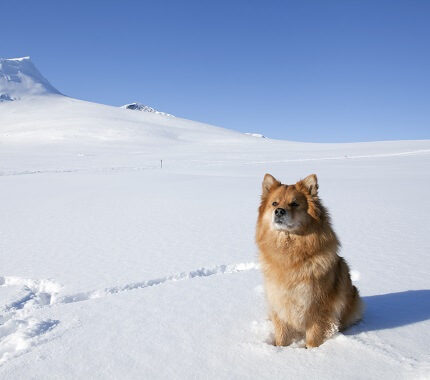
The Finnish Lapphund is a medium-sized herding dog that comes from north of the Arctic circle, where it is known to herd reindeer! Although this dog isn’t too well known outside of Scandinavia, it has been well developed and distinguished for nearly 3,000 years! The Finnish Lapphund gains its name from the region where it was developed. It was first developed by the Sami people, an indigenous, nomadic community that lives in the Arctic circle in an area known as Lapland. This area spans across Norway, Sweden, Finland, and Russia. Finnish Lapphunds were bred for hunting by the Sami people but they were predominantly used for herding reindeer, which is what they are more commonly known for. This dog is a descendant of the northern spitz. This breed of dog often appears much larger than it is due to the volume of its coat. Finnish Lapphunds are smart, quick to learn, and have an eager to please disposition. They have a smooth outer coat that can be wavy or straight and a dense undercoat. These dogs also have fringing or feathering on the backs of their legs, as well as on their underbelly and tails. The males have a much more profound coat than the females. The dense undercoat keeps these dogs warm in very cold weather, and also protects them from the heat in the summer. These dogs should never be shaved as it affects their ability to keep cool in hot weather. Finish Lapphunds come in a variety of colors, ranging from black to pure white. The typical colors are black or brown and the dogs may have tan or white markings, particularly around the face and on their legs. These nordic dogs are known to be active and energetic. They are quick and agile and have a lot of stamina and coordination which is important when herding other animals. Finnish Lapphunds can go from a trot to a full gallop in a second flat. The ‘Lappie bark’ is a predominant feature of this dog, which is known for being very vocal. Unlike other sheepdogs, this dog uses its bark to direct the animals it is herding. These dogs were recognized by the American Kennel Club as a herding breed in 2011. Today, only 11 Finnish Lapphunds live in the United States, whereas most of this breed are found thriving in the Arctic circle. They make good companions as they have loyal, calm, and keen personalities and are eager to please making them easier to train than some other breeds. The Finnish Lapphund is a unique dog that survives in some very harsh climates. It has many biological adaptations that make it well-suited for cold environments and help it to carry out its role herding reindeer. Let’s take a closer look! One distinctive breed trait of the Finnish Lapphund is that is has a strong startle reflex. This startle response is a largely unconscious defensive response to a sudden movement or stimuli that the dog was not expecting. While this response may be undesirable in a lot of dog breeds, it is important in the Finnish Lapphund as its primary role was herding reindeer. Reindeer are large animals with sharp antlers that could do a lot of damage if the dogs were not quick to react. Their strong startle reflex protects them from being trampled or kicked when herding. The startle reflex is a brainstem reflex reaction that’s role is to protect vulnerable parts of the animal, such as the back of the neck and the eyes. This reflex is meant to help the animal to escape from sudden stimuli. Researchers carried out DNA testing of the Finnish Lapphund and back-traced their lineage and what they discovered was really interesting! Mitochondrial DNA testing of this Nordic breed revealed that they belong to a subclade known as d1. This only occurs in dog breeds that originate from Scandinavia. This subclade can be traced back over 3,000 years and is shared by other breeds from the region, such as the Swedish Lapphund and the Norwegia Elkhound. Researchers discovered that this subclade occurred as a result of a female wolf mating with a domesticated male dog. The data suggested that this was a crossbreeding event between a domesticated dog and a wild animal, and not that the mating occurred in the wild and the dog was domesticated again at a later date. This has not been found anywhere else in Europe. The high frequency of the d1 subclade in Northern Scandinavia suggests that these dogs had a selective advantage. Certain breeds of dogs have snowshoe feet – a natural adaptation to life in the snow that works much the same way as human snowshoes. Snowshoes are specialized footwear that people may use to help them walk in snowy environments. These shoes help us to walk through the snow by providing a larger area over which our weight can be distributed. This prevents us from sinking into the snow. These shoes are also built in a way that prevents us from accumulating snow as we move. Finnish Lapphunds feet are oval rather than round. Their toes are spread out to create a larger surface area, and they have fur on their feet and in between their toes to help prevent the build-up of snow. This adaptation helps them to move quickly through snowy environments. Other dogs that have this adaptation are also found in snowy environments including Tibetan terries and Alaskan malamutes.
Kingdom
Animalia
Phylum
Chordata
Class
Mammalia
Order
Carnivora
Family
Canidae
Genus
Canis
Species
Canis lupus
Subspecies
Canis lupus familiaris
Height
16 – 21 in (41 – 53 cm) at the shoulder
Weight
33 – 53 lb (15 – 24 kg)
Lifespan
12 – 15 years
Social Structure
Domesticated
Status
Least concern
Natural Habitat
Domesticated, prefer herding activities
Average Litter Size
2 – 9
Main food item
Dog food
Potential predators
Few predators
The Basics

Fun Facts about the Finnish Lapphund!
Startle Reflex

Interesting DNA!

Snowshoe Feet
